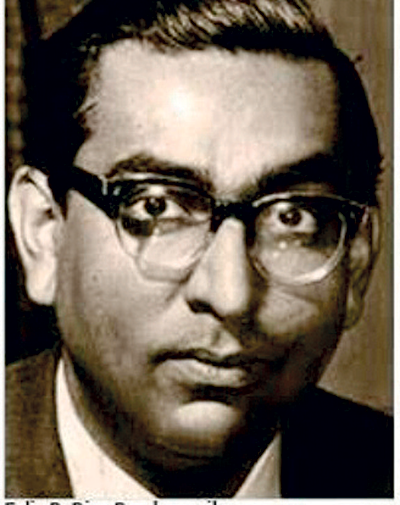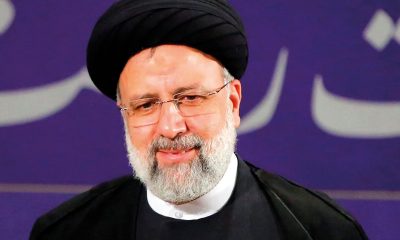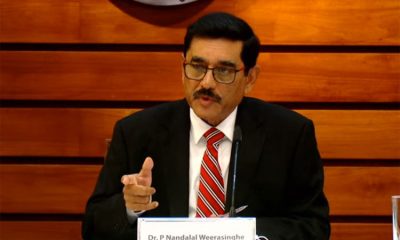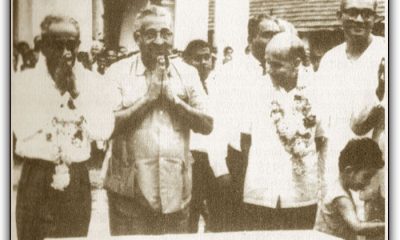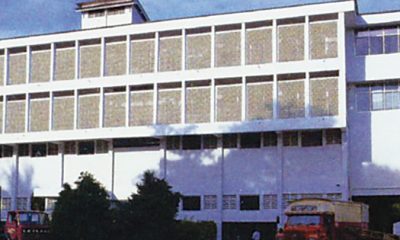Features
Cabinet squabbles over rice ration cut, PM threatens to resign
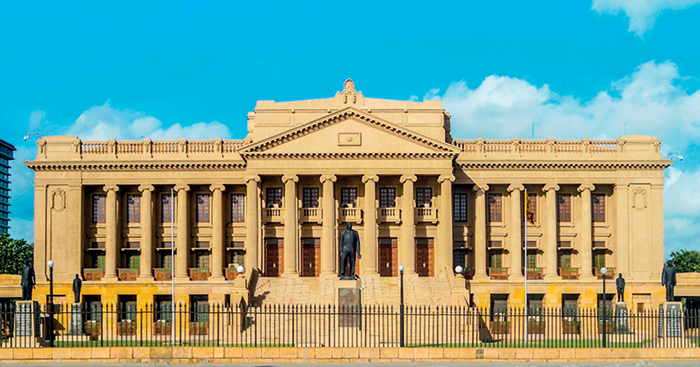
(Excerpted from the Memoirs of a Cabinet Secretary by BP Peiris)
Within a couple of days, another emergency meeting of the Cabinet was summoned, again at the instance of four Ministers, to consider the question of restoring the cut of half a measure imposed on the rice ration. The suggestion was made that if the rice coupons were taken away from those who had paddy, there would be a saving of Rs 20 million and, if certain other Votes were cut, the budget could be balanced. Felix stood his ground. He said he was not convinced that depriving paddy owners of their rice coupons was a satisfactory alternative proposal. If any satisfactory proposal was made, he was prepared to restore the half measure; but Ministers had no alternative proposal.
Regarding the proposed cut on the Votes, he asked whether the Minister of Education was prepared to forego his teachers, the Minister of Health his new hospitals, and the Minister of Irrigation his new and continuing works on his schemes. The Ministers were not prepared to reduce their Votes. With this deadlock the Cabinet had no option but to let the reduced ration stand. Ministerial feelings were strained and the Cabinet atmosphere appeared to be fully charged for an explosion.
Two days later (August 6, 1962) another Cabinet meeting was summoned for 7 p.m. to consider the same question. This meeting went on for two hours. The Prime Minister arrived with a very long face and I sensed trouble. She asked the Ministers bluntly what they were going to do about the rice ration. One Minister raised the old argument about taking the coupons off paddy owners. This was taken up by other Ministers. It was argued contra that the people of the Southern province would be badly affected if the cut was enforced because the people along the coast existed on rice and had no money to buy flour.
Others argued that peasants existed on breadfruit, jak, manioc etc. and had no use for flour. Felix Dias was silent, so was the Prime Minister. A suggestion was made that the whole position be considered six months later. Felix stood his ground again and retorted that he had presented a budget for 12 months and not for six months. There was wrangling in the Cabinet and the Prime Minister was obviously very angry. It was also said that many backbenchers of the Parliamentary Group were against the move to cut the rice ration and would vote against the Government or abstain from voting. Four votes were sufficient to defeat the Government but the Minister of Labour informed the Cabinet that they had twelve votes against them.
The Prime Minister pushed her chair back in an angry mood. She said she would resign and asked the Ministers to choose her successor. I had, at this stage, to remind the Prime Minister that her resignation implied the resignation of her entire Cabinet and that the question of her successor had to be left to the Governor-General. I can well imagine the extreme limit of endurance and patience to which she must have been driven by the petty-fogging and almost schoolboyish conduct on the part of her Ministers. She left the meeting abruptly. I did so myself without speaking to the other Ministers. At that moment, I felt very sorry for her.
Members of the Government Parliamentary Group anticipated defeat and were nervous that if they voted against the restoration of the rice ration cut and if the Prime Minister resigned and asked for a dissolution and a general election, they would not be able to show their faces in their electorates. It was therefore said that, at the last moment, a large number of party members might jump the stile so that they might win their seats. We had to wait and see. This was August 7, 1962 and a vote on the second reading of the budget was not due to be taken till the 20th.
Felix Dias had a proposal. He suggested that as a poor man’s family of husband, wife and, say, six children did not use their entire race ration but sold the ration books to boutiques and co-operative societies, the Government should offer them Rs 24 for each book surrendered. As there was a racket in the Guaranteed Price Scheme where the same quantity of paddy was known to go through the mills three or four times and where the cultivator, hard pressed for money, was paid Rs 7 or Rs 8 when the Government Price was Rs 12 per bushel, Felix proposed that the government should buy the paddy direct from the cultivator at Rs 12.
He said this would eliminate the racket in rice coupons. It was again proposed to give a ration of paddy to cultivators and cut the relevant number of coupons off their books. Which was to be decided was not agreed upon, but Madam Prime Minister asked that the matter be kept secret as this was part of the budget, the debate on which was to commence on August 16. A Cabinet meeting had been summoned for August 15 and someone disclosed the proposals which were awaiting discussion to the ‘Daily News’, embarrassing Felix Dias and the entire Cabinet.
The Prime Minister canceled the meeting and summoned the Ministers to meet unofficially to discuss the situation arising from this publication. I was not aware of what happened at this meeting but it was clear that that feeling of a collectively responsible Cabinet was fast disappearing.
Without any Cabinet decision of which I was aware, Ilangaratna announced in the House that the cut in the rice ration would take effect on October 22. Ministers were acting independently of one another. There was no team spirit. There was wrangling and maneuvering within the Cabinet and Felix Dias was forced as Finance Minister, at an emergency meeting on August 23, to withdraw the cut of half a measure in the rice ration. The Minister had no option but to resign. The Prime Minister now had nobody in the Cabinet on whom she could rely. ‘The Times of Ceylon’ commented on what happened as follows:
“That the wrangle within the Cabinet has developed into a crisis of sorts has been evident for some time now, but it is necessary to remind the Government that the country is faced with an even bigger crisis, the grave economic crisis which Ministerial pooh-poohing can no longer conjure away. It is the latter crisis which should take precedence in the Cabinet room, so that some serious and concerted efforts may be made to devise short term and long term remedies. Instead, the public interest is made a sort of football to be kicked from one end of the Cabinet room to the other.
“We refer specifically to the unseemly dispute about the rice ration, a dispute which has been reflected in successive announcements, one canceling out the other. Whether it was difficulty in obtaining supplies or (as we believe) the critical state of our foreign assets that prompted the budget proposal to cut the ration, this was obviously a matter for the most anxious consideration of the Cabinet as a whole before a firm decision was reached and announced. But no sooner was the cut announced that there were second, third and fourth thoughts, not among members of the opposition but in the Cabinet itself with the vagaries of the ministerial wrangle reflected in successive conflicting public announcements.
“When he broke the fateful news of the cut in the budget speech on July 26th, the Finance Minister said it would be effective “as far as possible from next week”. Five days later a commnique was issued saying that the cut would be made from August 13th. On August 2nd, however, the Government made the cryptic announcement that the implementation would be “on a date to be fixed by the Cabinet”. On August 3rd, after an emergency meeting of the Cabinet, it was stoutly denied that the cut would be operative from August 27th.
“Blame was heaped on ‘the newspapers’ which, it was announced, ‘had sought to infer that the Government had revised two major policy decisions contained in the budget speech regarding the sales tax and the reduction of the rice ration. The Government has not deviated in policy on either’. On August 15th the Minister of Agriculture’s proposed alternative to the rice ration cut was given publicity in the Press. Next day, August 16th, the Finance Minister told Parliament, ‘I would like to state quite clearly that the proposal before the House, and on which I have any information to give the House, still remain exactly where they were. There are no changes whatsoever.’ And now, this week, the Food Minister intervenes to tell Parliament that there may be no ration cut at all.
“The public have surely had enough of this farce. It would he pure comedy were the economic plight of the country not so tragic. There is indeed a crisis facing the nation, not merely an unseemly Cabinet wrangle but an economic crisis which may reduce the country to bankruptcy. In that context the squabbles within the Cabinet are an affront to the population. We reported on Monday that negotiation for foreign aid is to be given top priority by the Government. To beg abroad is no solution to our home-made economic difficulties. We hope the Cabinet will, at least in the grave pass to which the government had pushed the country, show a greater sense of decorum and responsibility than has been evident in recent weeks.”
Felix Dias was succeeded as Minister of Finance by C. P. de Silva who took the portfolio in addition to his other duties, an impossible task for any one man. In the meantime, Felix went round the country attacking C. P.’s finance policy from public platforms. C. P. handed back his portfolio and was succeeded by Kalugalla. Felix started the old game again and attacked Kalugalla in public. It amazed me that a Cabinet composed of men like this could ever have taken charge of the country’s affairs and, having taken charge, could have continued as a body for so long.
Kalugalla now tried his hand at finding ways and means of bridging the budget deficit. His proposals, which were not prepared in the Treasury but by a friend of his in the Central Bank, were approved. He asked Cabinet approval to increase the maximum statutory limit of Treasury Bills from Rs 1,000 million by a further Rs 150 million. Felix Dias asked why this was at all necessary. The Minister had made his proposals for bridging the budget deficit – then why more Treasury Bills?
Ultimately the increase was approved. At a subsequent meeting, Kalugalla stated that the deficit would be Rs 217 million, that his calculations had been wrong and that by his proposals only Rs 60 million could be raised. He therefore proposed to impose further taxation on a public which was already taxed to the utmost. He was asked to bring his tax proposals before the Cabinet.
Up to May 1963, Kalugalla had no proposals to make. On May 6, Parliament was prorogued till July 17, amid strong protests by all parties of the Opposition. As a result, over one hundred items on the Order Paper lapsed. The real reason for the unusually long prorogation was that, if the six appointed members were ignored, the Government had only a slender majority of two.
Features
The heart-friendly health minister

by Dr Gotabhya Ranasinghe
Senior Consultant Cardiologist
National Hospital Sri Lanka
When we sought a meeting with Hon Dr. Ramesh Pathirana, Minister of Health, he graciously cleared his busy schedule to accommodate us. Renowned for his attentive listening and deep understanding, Minister Pathirana is dedicated to advancing the health sector. His openness and transparency exemplify the qualities of an exemplary politician and minister.
Dr. Palitha Mahipala, the current Health Secretary, demonstrates both commendable enthusiasm and unwavering support. This combination of attributes makes him a highly compatible colleague for the esteemed Minister of Health.
Our discussion centered on a project that has been in the works for the past 30 years, one that no other minister had managed to advance.
Minister Pathirana, however, recognized the project’s significance and its potential to revolutionize care for heart patients.
The project involves the construction of a state-of-the-art facility at the premises of the National Hospital Colombo. The project’s location within the premises of the National Hospital underscores its importance and relevance to the healthcare infrastructure of the nation.
This facility will include a cardiology building and a tertiary care center, equipped with the latest technology to handle and treat all types of heart-related conditions and surgeries.
Securing funding was a major milestone for this initiative. Minister Pathirana successfully obtained approval for a $40 billion loan from the Asian Development Bank. With the funding in place, the foundation stone is scheduled to be laid in September this year, and construction will begin in January 2025.
This project guarantees a consistent and uninterrupted supply of stents and related medications for heart patients. As a result, patients will have timely access to essential medical supplies during their treatment and recovery. By securing these critical resources, the project aims to enhance patient outcomes, minimize treatment delays, and maintain the highest standards of cardiac care.
Upon its fruition, this monumental building will serve as a beacon of hope and healing, symbolizing the unwavering dedication to improving patient outcomes and fostering a healthier society.We anticipate a future marked by significant progress and positive outcomes in Sri Lanka’s cardiovascular treatment landscape within the foreseeable timeframe.
Features
A LOVING TRIBUTE TO JESUIT FR. ALOYSIUS PIERIS ON HIS 90th BIRTHDAY

by Fr. Emmanuel Fernando, OMI
Jesuit Fr. Aloysius Pieris (affectionately called Fr. Aloy) celebrated his 90th birthday on April 9, 2024 and I, as the editor of our Oblate Journal, THE MISSIONARY OBLATE had gone to press by that time. Immediately I decided to publish an article, appreciating the untiring selfless services he continues to offer for inter-Faith dialogue, the renewal of the Catholic Church, his concern for the poor and the suffering Sri Lankan masses and to me, the present writer.
It was in 1988, when I was appointed Director of the Oblate Scholastics at Ampitiya by the then Oblate Provincial Fr. Anselm Silva, that I came to know Fr. Aloy more closely. Knowing well his expertise in matters spiritual, theological, Indological and pastoral, and with the collaborative spirit of my companion-formators, our Oblate Scholastics were sent to Tulana, the Research and Encounter Centre, Kelaniya, of which he is the Founder-Director, for ‘exposure-programmes’ on matters spiritual, biblical, theological and pastoral. Some of these dimensions according to my view and that of my companion-formators, were not available at the National Seminary, Ampitiya.
Ever since that time, our Oblate formators/ accompaniers at the Oblate Scholasticate, Ampitiya , have continued to send our Oblate Scholastics to Tulana Centre for deepening their insights and convictions regarding matters needed to serve the people in today’s context. Fr. Aloy also had tried very enthusiastically with the Oblate team headed by Frs. Oswald Firth and Clement Waidyasekara to begin a Theologate, directed by the Religious Congregations in Sri Lanka, for the contextual formation/ accompaniment of their members. It should very well be a desired goal of the Leaders / Provincials of the Religious Congregations.
Besides being a formator/accompanier at the Oblate Scholasticate, I was entrusted also with the task of editing and publishing our Oblate journal, ‘The Missionary Oblate’. To maintain the quality of the journal I continue to depend on Fr. Aloy for his thought-provoking and stimulating articles on Biblical Spirituality, Biblical Theology and Ecclesiology. I am very grateful to him for his generous assistance. Of late, his writings on renewal of the Church, initiated by Pope St. John XX111 and continued by Pope Francis through the Synodal path, published in our Oblate journal, enable our readers to focus their attention also on the needed renewal in the Catholic Church in Sri Lanka. Fr. Aloy appreciated very much the Synodal path adopted by the Jesuit Pope Francis for the renewal of the Church, rooted very much on prayerful discernment. In my Religious and presbyteral life, Fr.Aloy continues to be my spiritual animator / guide and ongoing formator / acccompanier.
Fr. Aloysius Pieris, BA Hons (Lond), LPh (SHC, India), STL (PFT, Naples), PhD (SLU/VC), ThD (Tilburg), D.Ltt (KU), has been one of the eminent Asian theologians well recognized internationally and one who has lectured and held visiting chairs in many universities both in the West and in the East. Many members of Religious Congregations from Asian countries have benefited from his lectures and guidance in the East Asian Pastoral Institute (EAPI) in Manila, Philippines. He had been a Theologian consulted by the Federation of Asian Bishops’ Conferences for many years. During his professorship at the Gregorian University in Rome, he was called to be a member of a special group of advisers on other religions consulted by Pope Paul VI.
Fr. Aloy is the author of more than 30 books and well over 500 Research Papers. Some of his books and articles have been translated and published in several countries. Among those books, one can find the following: 1) The Genesis of an Asian Theology of Liberation (An Autobiographical Excursus on the Art of Theologising in Asia, 2) An Asian Theology of Liberation, 3) Providential Timeliness of Vatican 11 (a long-overdue halt to a scandalous millennium, 4) Give Vatican 11 a chance, 5) Leadership in the Church, 6) Relishing our faith in working for justice (Themes for study and discussion), 7) A Message meant mainly, not exclusively for Jesuits (Background information necessary for helping Francis renew the Church), 8) Lent in Lanka (Reflections and Resolutions, 9) Love meets wisdom (A Christian Experience of Buddhism, 10) Fire and Water 11) God’s Reign for God’s poor, 12) Our Unhiddden Agenda (How we Jesuits work, pray and form our men). He is also the Editor of two journals, Vagdevi, Journal of Religious Reflection and Dialogue, New Series.
Fr. Aloy has a BA in Pali and Sanskrit from the University of London and a Ph.D in Buddhist Philosophy from the University of Sri Lankan, Vidyodaya Campus. On Nov. 23, 2019, he was awarded the prestigious honorary Doctorate of Literature (D.Litt) by the Chancellor of the University of Kelaniya, the Most Venerable Welamitiyawe Dharmakirthi Sri Kusala Dhamma Thera.
Fr. Aloy continues to be a promoter of Gospel values and virtues. Justice as a constitutive dimension of love and social concern for the downtrodden masses are very much noted in his life and work. He had very much appreciated the commitment of the late Fr. Joseph (Joe) Fernando, the National Director of the Social and Economic Centre (SEDEC) for the poor.
In Sri Lanka, a few religious Congregations – the Good Shepherd Sisters, the Christian Brothers, the Marist Brothers and the Oblates – have invited him to animate their members especially during their Provincial Congresses, Chapters and International Conferences. The mainline Christian Churches also have sought his advice and followed his seminars. I, for one, regret very much, that the Sri Lankan authorities of the Catholic Church –today’s Hierarchy—- have not sought Fr.
Aloy’s expertise for the renewal of the Catholic Church in Sri Lanka and thus have not benefited from the immense store of wisdom and insight that he can offer to our local Church while the Sri Lankan bishops who governed the Catholic church in the immediate aftermath of the Second Vatican Council (Edmund Fernando OMI, Anthony de Saram, Leo Nanayakkara OSB, Frank Marcus Fernando, Paul Perera,) visited him and consulted him on many matters. Among the Tamil Bishops, Bishop Rayappu Joseph was keeping close contact with him and Bishop J. Deogupillai hosted him and his team visiting him after the horrible Black July massacre of Tamils.
Features
A fairy tale, success or debacle

Sri Lanka-Singapore Free Trade Agreement
By Gomi Senadhira
senadhiragomi@gmail.com
“You might tell fairy tales, but the progress of a country cannot be achieved through such narratives. A country cannot be developed by making false promises. The country moved backward because of the electoral promises made by political parties throughout time. We have witnessed that the ultimate result of this is the country becoming bankrupt. Unfortunately, many segments of the population have not come to realize this yet.” – President Ranil Wickremesinghe, 2024 Budget speech
Any Sri Lankan would agree with the above words of President Wickremesinghe on the false promises our politicians and officials make and the fairy tales they narrate which bankrupted this country. So, to understand this, let’s look at one such fairy tale with lots of false promises; Ranil Wickremesinghe’s greatest achievement in the area of international trade and investment promotion during the Yahapalana period, Sri Lanka-Singapore Free Trade Agreement (SLSFTA).
It is appropriate and timely to do it now as Finance Minister Wickremesinghe has just presented to parliament a bill on the National Policy on Economic Transformation which includes the establishment of an Office for International Trade and the Sri Lanka Institute of Economics and International Trade.
Was SLSFTA a “Cleverly negotiated Free Trade Agreement” as stated by the (former) Minister of Development Strategies and International Trade Malik Samarawickrama during the Parliamentary Debate on the SLSFTA in July 2018, or a colossal blunder covered up with lies, false promises, and fairy tales? After SLSFTA was signed there were a number of fairy tales published on this agreement by the Ministry of Development Strategies and International, Institute of Policy Studies, and others.
However, for this article, I would like to limit my comments to the speech by Minister Samarawickrama during the Parliamentary Debate, and the two most important areas in the agreement which were covered up with lies, fairy tales, and false promises, namely: revenue loss for Sri Lanka and Investment from Singapore. On the other important area, “Waste products dumping” I do not want to comment here as I have written extensively on the issue.
1. The revenue loss
During the Parliamentary Debate in July 2018, Minister Samarawickrama stated “…. let me reiterate that this FTA with Singapore has been very cleverly negotiated by us…. The liberalisation programme under this FTA has been carefully designed to have the least impact on domestic industry and revenue collection. We have included all revenue sensitive items in the negative list of items which will not be subject to removal of tariff. Therefore, 97.8% revenue from Customs duty is protected. Our tariff liberalisation will take place over a period of 12-15 years! In fact, the revenue earned through tariffs on goods imported from Singapore last year was Rs. 35 billion.
The revenue loss for over the next 15 years due to the FTA is only Rs. 733 million– which when annualised, on average, is just Rs. 51 million. That is just 0.14% per year! So anyone who claims the Singapore FTA causes revenue loss to the Government cannot do basic arithmetic! Mr. Speaker, in conclusion, I call on my fellow members of this House – don’t mislead the public with baseless criticism that is not grounded in facts. Don’t look at petty politics and use these issues for your own political survival.”
I was surprised to read the minister’s speech because an article published in January 2018 in “The Straits Times“, based on information released by the Singaporean Negotiators stated, “…. With the FTA, tariff savings for Singapore exports are estimated to hit $10 million annually“.
As the annual tariff savings (that is the revenue loss for Sri Lanka) calculated by the Singaporean Negotiators, Singaporean $ 10 million (Sri Lankan rupees 1,200 million in 2018) was way above the rupees’ 733 million revenue loss for 15 years estimated by the Sri Lankan negotiators, it was clear to any observer that one of the parties to the agreement had not done the basic arithmetic!
Six years later, according to a report published by “The Morning” newspaper, speaking at the Committee on Public Finance (COPF) on 7th May 2024, Mr Samarawickrama’s chief trade negotiator K.J. Weerasinghehad had admitted “…. that forecasted revenue loss for the Government of Sri Lanka through the Singapore FTA is Rs. 450 million in 2023 and Rs. 1.3 billion in 2024.”
If these numbers are correct, as tariff liberalisation under the SLSFTA has just started, we will pass Rs 2 billion very soon. Then, the question is how Sri Lanka’s trade negotiators made such a colossal blunder. Didn’t they do their basic arithmetic? If they didn’t know how to do basic arithmetic they should have at least done their basic readings. For example, the headline of the article published in The Straits Times in January 2018 was “Singapore, Sri Lanka sign FTA, annual savings of $10m expected”.
Anyway, as Sri Lanka’s chief negotiator reiterated at the COPF meeting that “…. since 99% of the tariffs in Singapore have zero rates of duty, Sri Lanka has agreed on 80% tariff liberalisation over a period of 15 years while expecting Singapore investments to address the imbalance in trade,” let’s turn towards investment.
Investment from Singapore
In July 2018, speaking during the Parliamentary Debate on the FTA this is what Minister Malik Samarawickrama stated on investment from Singapore, “Already, thanks to this FTA, in just the past two-and-a-half months since the agreement came into effect we have received a proposal from Singapore for investment amounting to $ 14.8 billion in an oil refinery for export of petroleum products. In addition, we have proposals for a steel manufacturing plant for exports ($ 1 billion investment), flour milling plant ($ 50 million), sugar refinery ($ 200 million). This adds up to more than $ 16.05 billion in the pipeline on these projects alone.
And all of these projects will create thousands of more jobs for our people. In principle approval has already been granted by the BOI and the investors are awaiting the release of land the environmental approvals to commence the project.
I request the Opposition and those with vested interests to change their narrow-minded thinking and join us to develop our country. We must always look at what is best for the whole community, not just the few who may oppose. We owe it to our people to courageously take decisions that will change their lives for the better.”
According to the media report I quoted earlier, speaking at the Committee on Public Finance (COPF) Chief Negotiator Weerasinghe has admitted that Sri Lanka was not happy with overall Singapore investments that have come in the past few years in return for the trade liberalisation under the Singapore-Sri Lanka Free Trade Agreement. He has added that between 2021 and 2023 the total investment from Singapore had been around $162 million!
What happened to those projects worth $16 billion negotiated, thanks to the SLSFTA, in just the two-and-a-half months after the agreement came into effect and approved by the BOI? I do not know about the steel manufacturing plant for exports ($ 1 billion investment), flour milling plant ($ 50 million) and sugar refinery ($ 200 million).
However, story of the multibillion-dollar investment in the Petroleum Refinery unfolded in a manner that would qualify it as the best fairy tale with false promises presented by our politicians and the officials, prior to 2019 elections.
Though many Sri Lankans got to know, through the media which repeatedly highlighted a plethora of issues surrounding the project and the questionable credentials of the Singaporean investor, the construction work on the Mirrijiwela Oil Refinery along with the cement factory began on the24th of March 2019 with a bang and Minister Ranil Wickremesinghe and his ministers along with the foreign and local dignitaries laid the foundation stones.
That was few months before the 2019 Presidential elections. Inaugurating the construction work Prime Minister Ranil Wickremesinghe said the projects will create thousands of job opportunities in the area and surrounding districts.
The oil refinery, which was to be built over 200 acres of land, with the capacity to refine 200,000 barrels of crude oil per day, was to generate US$7 billion of exports and create 1,500 direct and 3,000 indirect jobs. The construction of the refinery was to be completed in 44 months. Four years later, in August 2023 the Cabinet of Ministers approved the proposal presented by President Ranil Wickremesinghe to cancel the agreement with the investors of the refinery as the project has not been implemented! Can they explain to the country how much money was wasted to produce that fairy tale?
It is obvious that the President, ministers, and officials had made huge blunders and had deliberately misled the public and the parliament on the revenue loss and potential investment from SLSFTA with fairy tales and false promises.
As the president himself said, a country cannot be developed by making false promises or with fairy tales and these false promises and fairy tales had bankrupted the country. “Unfortunately, many segments of the population have not come to realize this yet”.
(The writer, a specialist and an activist on trade and development issues . )

